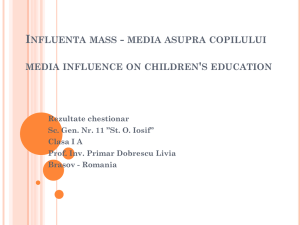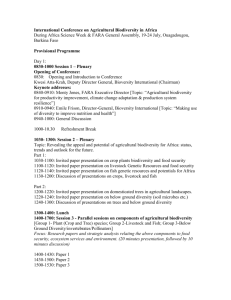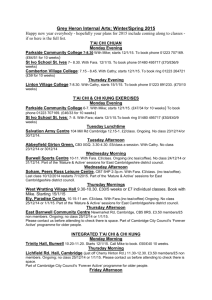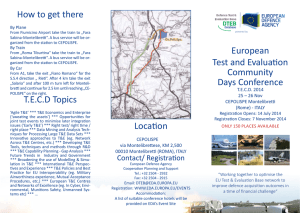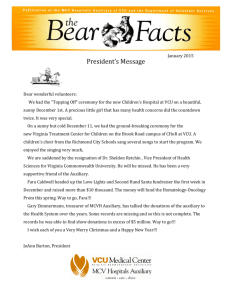Annual Report 2009
advertisement
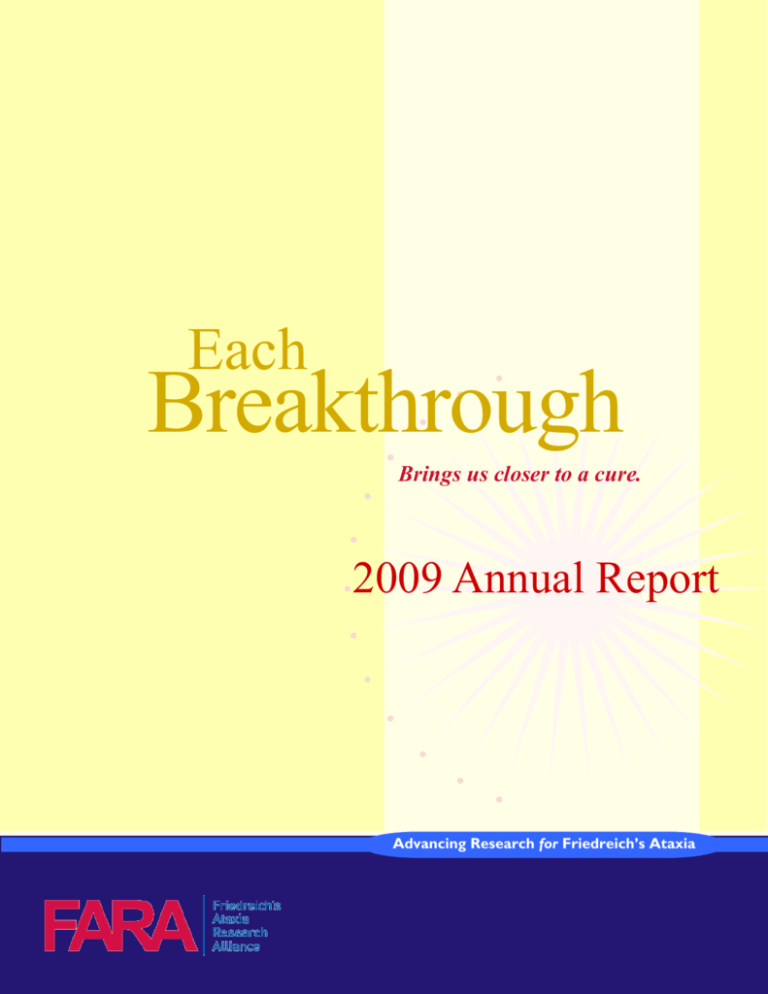
Each Breakthrough Brings us closer to a cure. 2009 Annual Report Advancing Research for Friedreich’s Ataxia From the Chairman Dear Friends of FARA: I am glad that I am not a scientist. In the two or so years that I have been involved with FARA, I have come to appreciate how difficult FA science is to do and to understand. Ron, Jen, and scientists such as Dave Lynch and Earl Giller have been patient with me, but it is clearly an uphill battle as is the battle against FA. One big difference is that the FA battle is being won. Another year has gone by, and we are one year closer to the audacious goal FARA set for itself: To find a cure for FA by 2012. Much of the credit goes to the executive team – Ron, Jen, Juliann, and Felicia – and much more goes to our FARA families, personal and corporate friends of the families, and the cadre of scientists who have dedicated themselves to understanding and conquering Friedreich’s Ataxia. Our two strategic initiatives – science and fundraising – have been in place for just over a year and are sowing dividends. We had our first clinical trial funded solely by FARA – a test of Varenicline – and we continue to broaden and deepen our research pipeline all over the world. More trials are underway and although never fast enough, we are making progress toward our goal and receiving high marks for the quality of the science characteristic of FA research. Fundraising continues to improve. FARA was able to grow even in the worst economic environment in decades due to the efforts of patient families, friends, and corporate supporters. Outback Restaurant Partners, LLC set the standard for corporate generosity and was our Partner of the Year. It seems as though there is a local fundraising event somewhere almost every weekend thanks to the FARA families. And a special thanks to Paul and Suzanne Avery. It is through their leadership and generosity that the first Energy Ball came to life as a very successful fundraising event in Tampa Bay, Florida. The second Energy Ball is scheduled for this August. We hope that you will be able to help support this event. Education and communication continue to be an important adjunct to success. As an ―orphan disease‖ FA needs all the publicity it can get. On several fronts, that is exactly what we are doing. FARA is at the table with important organizations such as NIH, FDA, and other non-profits and drug companies. And we are in motion—literally, with Ride Ataxia and Race Across America—and Kyle Bryant. Kyle will tell you that his rides are fun rides, and they are for some. For others such as yours truly, they are a test of will and raise questions about Kyle’s grip on reality. But what cannot be questioned are their value to getting our name before the public and our disease a little better understood. Awareness and understanding are important ingredients to finding a cure. Thanks to each of you for your support and inspiration, Tom DeCotiis, Ph.D. FARA Overview About FARA The Friedreich's Ataxia Research Alliance (FARA) has been dedicated to advancing research for Friedreich’s ataxia for over 11 years. In scientific research terms, that’s not a lot of time. However, in that period, FARA has established a robust and admired program that has attracted the world’s best scientists, advanced numerous treatment opportunities and forged collaborative relationships around the globe. FARA grants and activities provide support for basic and translational FA research, pharmaceutical/biotech drug development, clinical trials, and scientific conferences. FARA also serves as a catalyst between the public and scientific communities, to create worldwide exchanges of information that drive medical advances. Mission FARA Staff FARA's Mission is to marshal and focus the resources and relationships needed to cure FA by raising funds for research, promoting public awareness, and aligning scientists, patients, clinicians, government agencies, pharmaceutical companies and other organizations dedicated to curing FA and related diseases. Ron Bartek Co-Founder and President Jennifer Farmer, MS, CGC Executive Director Giovanni Manfredi, MD, PhD Chief Scientific Officer Bronya Keats, PhD Chief Scientific Officer Juliann Green Chief Development Officer Raychel Furr Bartek Co-Founder and Patient- Family Liaison Felicia DeRosa, MPA Program Director Kyle Bryant, Founder, Ride Ataxia Ride Ataxia Director, FARA Spokesperson Fiscal Approach A donor-supported organization, FARA allocates its funds in an ethical and responsible manner that exceeds the standards set for the non-profit industry. We are especially grateful to those who helped us advance our mission in fiscal year 2009 by contributing to revenues of $3.5 million. As we expand our efforts, the board and staff remain vigilant about careful stewardship of FARA finances. In 2009, we have kept our fundraising and general operating and administrative expenses to about 17% of our overall revenue for the How FARA funds were year. This is largely possible utilized in 2009 General because of the significant Administration volunteer and in-kind and Fundraising support we receive for our events. Lyn Sgrillo Executive Assistant Join Our Mission Learn how you can support FARA’s efforts to treat and Cure FA at www.curefa.org/help.html Program Services Advancing Research for Friedreich’s Ataxia 2009 Achievements Keeping our goals in focus Insight from Jen Farmer, Executive Director The Collaborative Clinical Research Network in FA (CCRN in FA) is a critical component of FARA’s research program. Without it and the valuable patient information obtained through the clinic sites (10 as of 2009), our research would be nearly impossible. In 2009, The CCRN in FA: recruited and evaluated 100 new patients saw more than 550 patients provided data, advice and biological samples for planning and conducting numerous clinical trials and research studies provided the infrastructure for two clinical trials initiated scientific studies to evaluate new clinical outcome measures of speech, hearing and vision grew the DNA bank to more than 300 samples enabling the first genetic modifier studies hosted an FA Patient Symposium with over 150 patient families from the United States, Canada, Ireland, England and Austria in attendance. FARA awarded 23 grants in 2009 Total 2009 research program = $1,805,854 FA Patient Registry enrollment grew to 1,250 As FARA’s Executive Director, I am responsible for ensuring that all of the programs, activities and operations of the organization support FARA’s Strategic Initiatives and are carried out in the most efficient and effective manner. Our strategic initiatives are centered on advancing FA research, raising the funds necessary to accomplish our goals and communicating effectively with all constituents and the general public to ensure that FA is understood and considered in the rare disease dialogue. While FARA’s primary focus is on advancing FA research and bringing forward treatments, many other ancillary activities are critical to support and facilitate these goals including ongoing development of our research infrastructure and continuing to grow our revenues to match our increasing costs of research. The Collaborative Clinical Research Network in FA is one major example of how vital it is for FARA to maintain its research infrastructure. Our scientific community, pharmaceutical partners and collaborators count on this infrastructure to support their research. As you’ll read in the column to the left, the CCRN in FA made many significant contributions to the advancement of FA research in 2009. This was made possible through FARA funding, direction and leadership. Here are just a few examples of how our research program expanded in 2009: We nearly doubled the number of grant applications reviewed in a single year Our research agenda was expanded to areas such as new forms of cell models and improved mouse models. FARA hosted an International FA therapeutics symposium which guided the FARA scientific advisory board in crafting our goals for 2010 and beyond. See next page for more detail. Most important, five of the lead candidates identified in FARA’s strategic initiatives for advancement were in clinical trials this year. See the current FARA Pipeline. Highlights of additional progress are included in this report. More information is available at www.curefa.org. As we have from our beginnings, FARA relies heavily on the passion and commitment of our volunteers to help us carry out our mission. We could not accomplish all that we have in 2009 without the energy, expertise and hearts of many. 2009 Achievements 2009 Research Highlights Kyle Bryant Translational Research Awards Growing our Scientific Expertise In 2009, FARA and the National Ataxia Foundation (NAF) made three grant awards through the Kyle Bryant Translational Research Award Program: Protein Replacement Principal Investigator: Dr. Mark Payne, Indiana University School of Medicine—Optimizing delivery of frataxin using cell penetrant peptides Drug discovery toward improving mitochondrial function Principal Investigator: Dr. Gino Cortopassi, University of California, Davis—Screening for mitofunctional Friedreich’s ataxia therapeutics New strategies to regulate FRDA gene activity Principal Investigator: Marek Napierala, University of Texas, MD Anderson Cancer Center—Crosstalk between microRNAs and iron metabolism in pathogenesis of Friedreich’s ataxia FARA believes in welcoming, mentoring and supporting new scientists in the FA research community. In 2009, FARA presented its New Investigator Award to Dr. Marguerite Evans- Galea of Dr. Marguerite Evans-Galea Murdoch Children’s Research Institute, Australia. Therapeutics Symposium More than 100 FA researchers and advocacy partners from around the world gathered in July 2009 for the FA Therapeutics Symposium in Philadelphia, PA. Presentations and discussions highlighted: progress in the development of previously identified therapeutic candidates, such as HDACI and TAT-Frataxin results from clinical trials including the Phase I study of A0001 and Phase III of Idebenone recent discoveries that point to new therapies advancements in new cell models, as well as drug discovery and development assays clinical research including biomarker studies and new clinical outcome measures. Formation of animal model task force In addition to sharing progress and insights on various aspects of FA therapeutics and development, participants were encouraged to discuss and identify key assets that would accelerate progress significantly. Since the symposium, FARA has awarded research grants, formed task forces, and fostered collaborations and new partnerships to develop these assets. Dr. Evans-Galea has a strong background in molecular biology and genetics, which includes research on understanding oxidative stress response in biological systems and direct experience with developing gene therapy approaches for other genetic conditions. The title of the study she will conduct with the award is ―Evaluating the Molecular and Epigenetic Alterations in Friedreich’s Ataxia‖. Through this study, Dr. Evans-Galea will investigate the variability in FA and explore genetic-based explanations or controls, beyond the DNA sequence of the FRDA gene, for such variability. FARA’ s unwavering commitment to collaboration has resulted in numerous scientific and funding partnerships around the world including: AFAF—France Ataxia UK—UK AHA—US CAFA—Canada FEDAES—Spain GoFAR—Italy FARA—Australasia FASI—Ireland Euro Ataxia—Europe MDA—US NAF—US NIH—US Advancing Research for Friedreich’s Ataxia Growing Awareness and Support Giving FARA and FA a Public Face FARA’s Ambassador on wheels—Kyle Bryant Growing Support for our Mission In 2009, FARA’s event-based fundraising program grew in size and number of events. FA families and their communities have continued to sustain critical core FARA funding through local events as they have done since FARA’s beginning. Events organized and hosted by FA families in 2009 numbered well over 35 in 16 different states and included athletic and social gatherings. Outback Steakhouse restaurants across the country also continued their generous fundraising activity in 2009. Their more than 25 events included luncheons, Heineken with a Heart happy hours, walks/runs, golf and sporting clays. FARA added two of its own branded events in 2009—Ride Ataxia and the FARA Energy Ball. Ride Ataxia became FARA’s family/community–focused fundraiser with a kick-off in the rolling hills of Philadelphia’s suburbs. The one-day, multipledistance format allowed people of all ages and abilities to participate. The first FARA Energy Ball gala in Tampa, FL welcomed 600 guests to three days of activities true to its namesake. Hosted by a dynamic and creative organizing committee in Tampa, the event kicked off with an educational symposium, included tennis and golf, and culminated in a gala dinner/auction. Friedreich’s ataxia is a rare disease that struggles for attention because of small numbers. However, just like in our research, FARA is gaining momentum and recognition in the public eye. In October 2009, FARA offered me the opportunity to represent the cause as the FARA spokesperson and the director of our Ride Ataxia cycling events. Before officially joining the FARA team, I worked with FARA promoting events and raising funds. In the last quarter of 2009, I presented the FARA story to nine audiences including fundraisers, scientific conferences, business managers and schools. FARA has also experienced high visibility in online communities including our FaceBook Fan page introduced at the end of the year (As of mid-2010, we have more than 2200 fans) and YouTube videos that had over 9,000 views by the end of 2009 and the Ride Ataxia Blog which experienced 7,000 unique views from 95 different countries in 2008 and 2009. Public interest is building. FARA’s Ride Ataxia program began with a resounding success in Philadelphia on October 25, 2009. This ride included 350 participants, half of whom had never heard of Friedreich’s ataxia. The participants also included eight members of the FA community on trikes, and representatives from 20 families affected by FA – from nearby and as far away as California. 2009 was a successful year in terms of raising awareness in the public eye and FARA looks forward to success in the future on the road toward the goal. Awareness is a community effort and I look forward to working with YOU to advance the FARA story. With your help, we will find a cure. FARA fundraising event revenues exceeded $2 Million in 2009, doubling the revenues from event-based fundraising of the previous year. This growth was due in large part to proceeds exceeding $850,000 from the first annual FARA Energy Ball. Additionally, revenues from the two 2009 Ride Ataxia events exceeded $390,000. We want to thank al of our fundraisers on behalf of the FA community. Your energy and dedication to FARA’s mission provide the momentum propelling research forward. Driving Success through Collaboration Joint Venture Philanthropy—FARA style A Model for Rare Disease Advocacy From its early years, FARA has been recognized as a model for rare disease advocacy organizations. FARA supports our pharmaceutical partners with funding, patient recruitment, scientific expertise and advocacy with organizations such as the NIH and MDA. A0001—Edison, Penwest, University of Pennsylvania In 2005, FARA provided substantial support to a small biotech company, Edison Pharmaceuticals, that was advancing what it called the ―next generation‖ of the CoQ10 enzyme. FARA led a collaborative effort along with Edison and Dr. Robert Wilson at the University of Pennsylvania to secure support from the NIH RAID (Rapid Access to Interventional Development) program to help fund the pre-clinical development of what would become A0001. Subsequently, the compound was licensed to Penwest Pharmaceuticals who completed Phase I safety and dose-finding studies in 2009. FARA also organized and facilitated meetings between Penwest and FARA clinical investigators such as Dr. David Lynch to help plan for Phase II studies scheduled for 2010. (These studies are now in progress.) FARA’s Patient Registry—adding value to our partnerships In 2009, FARA’s patient registry supported recruitment of participants for clinical research by pharmaceutical partners and academic scientists. This registry is the critical link to successful research and is invaluable in enabling and accelerating FARA’s remarkably active clinical trial program. Most clinical trials fail— usually from insufficient patient participation. Drug companies often spend millions of dollars and a lot of time recruiting patients for trials. It is not unusual for companies to devote two years to recruitment. We cannot allow that to happen. FARA is urgently pursuing treatments and a cure and cannot spend years recruiting patients for trials. Nor can we permit trials to fail because of insufficient patient participation. Enter the FARA patient registry. With it, we have been able to recruit sufficient FA patients for clinical trials in weeks, not months or years, and none of the FA trials have failed for lack of sufficient participants. Jubilant finishers from Ride Ataxia II — Portland to Seattle. The Ride resulted in $360,000 for translational research. Varenicline 2009 marked the first clinical trial funded by FARA. FARA acted quickly when Principal Investigator, Dr. Theresa Zesiewicz, at the University of South Florida CCRN in FA site found that symptoms of a cerebellar ataxia patient improved while taking Chantix®. Zesiewicz subsequently found similar results when treating patients with other types of ataxia, including Friedreich’s ataxia. After a thorough review by FARA’s scientific committee, FARA proceeded to fund, for the first time on its own, a clinical trial to investigate varenicline (Chantix®), and did so at two FARA CCRN in FA sites, USF and the Children’s Hospital of Philadelphia. The trial continued into 2010. Regardless of final outcome, the trial identified a potential novel mechanism of action in the nervous system that may provide additional opportunities for treatment in FA. Advancing Research Research for for Friedreich’s Friedreich’s Ataxia Ataxia Advancing Frequently Asked Questions FARA is focused on driving research that will lead to treatments and a cure for FA. Our program is held up as a model for other rare diseases due to our intense focus on an open, collaborative environment that speeds innovation. The pace of research is quickening. More researchers are joining the FARA team and more pharmaceutical companies are taking notice of our work. Below are answers to questions about FARA’s scientific program and other common areas of interest of our supporters. How does the FARA grant process work? FARA has provided more than $14 million in research funding over the past 12 years. Grants are provided for general research, to encourage new investigators focused on FA, for specific areas of FARA interest and for workshops and meetings. All grant applications submitted to FARA are thoroughly reviewed in a professional and confidential "dual-review" process modeled after that of the NIH. First, FARA's Scientific Review Committee performs a preliminary review, followed by reviews by peers competent in the applicant’s scientific area. Based on the peer-reviews, as well as the significance and relevance of the proposal to FARA’s mission and strategic priorities, the Committee makes a recommendation to proceed to FARA’s Board of Directors, which decides the level of funding to award to each meritorious grant. Within 60 days following completion of the grant period, Grantees are required to submit a report on the results. In some cases, interim reports are also required. How does FARA decide what research to pursue? In the early years, funding priorities were focused on understanding the causes of FA. While there is still more to learn about the intricacies of this disease, we have expanded our focus to translational and clinical research. You can review FARA’s pipeline at www.curefa.org/pipeline.html FARA’s Grant Program Priorities Advance drug discovery and maintain a diverse treatment pipeline Facilitate drug development and translational research so that the most promising discoveries are rapidly brought to treatment trials Support the clinical research, infrastructure and biomarker discovery required to ensure effective and efficient clinical trials in a rare disease Support young/new researchers with innovative ideas and a commitment to FA research Reduce the morbidity and mortality caused by cardiac disease in FA What is FARA doing to attract interest from the scientific and pharmaceutical community? To maximize our presence in the research community, FARA attends and presents at professional conferences, addresses research groups, pharmaceutical companies, student and professional groups and other forums. We serve on numerous committees and advisory groups including those at the National Institutes of Health (NIH) and National Organization of Rare Diseases (NORD). How does FARA use funds that are donated to the organization? Donations support all of the programs described in this report, including scientific research, awareness and education, as well as the internal staffing and resources needed to operate the organization. Why does FARA need to increase fundraising activity? As FARA’s research efforts have moved from the laboratory into the clinical setting, the costs of research have risen dramatically. In order to maintain our research momentum and lead our most promising treatments through drug development and clinical trials, we need more funding than FARA is currently receiving. How can I stay more connected and informed on FARA’s progress? FARA provides timely information on our website, Facebook Fan page and through our e-mail notifications. Please join our mailing list to receive information and FARA news. There are options for research news, Ride Ataxia and for general FARA updates. You may unsubscribe at any time. If you are a patient, please make sure that you are subscribed to FARA’s Patient Registry. You will receive notifications of clinical trials and scientific studies in which you may be qualified to participate. The Financials FRIEDREICH’S ATAXIA RESEARCH ALLIANCE STATEMENTS OF FINANCIAL POSITION December 31, 2009 and 2008 2009 2008 ASSETS CURRENT ASSETS Cash and cash equivalents Receivables Pledges receivable Prepaid expenses Investment in preferred stock TOTAL CURRENT ASSETS COMPUTER EQUIPMENT, net of accumulated depreciation of $484 (2009) and $21(2008) TOTAL ASSETS LIABILITIES AND NET ASSETS CURRENT LIABILITIES Accounts payable Accrued payroll liabilities TOTAL CURRENT LIABILITIES NET ASSETS Unrestricted Temporarily restricted TOTAL NET ASSETS TOTAL LIABILITIES AND NET ASSETS $2,171,396 85,374 50,000 2,280 1,100,000 3,409,050 $1,166,981 44,621 1,124 1,100,000 2,312,726 3,310 $3,412,360 808 $2,313,534 $194,935 2,167 197,102 $151 10,377 10,528 2,665,258 550,000 3,215,258 $ 3,412,360 2,303,006 2,303,006 $ 2,313,534 The independently audited financial statements of the Friedreich’s Ataxia Research Alliance are available online at www.cureFA.org, or by contacting Friedreich’s Ataxia Research Alliance, 102 Pickering Way, Suite 200, Exton, PA 19341/Phone: 484-875-3015 FARA Donor Bill of Rights PHILANTHROPY is based on voluntary action for the common good. It is a tradition of giving and sharing that is primary to the quality of life. To ensure that philanthropy merits the respect and trust of the general public, and that donors and prospective donors can have full confidence in the Friedreich’s Ataxia Research Alliance (FARA), FARA declares that all donors have these rights: I. To be informed of FARA’s mission, of the way FARA intends to use donated resources, and of its capacity to use donations effectively for their intended purposes. II. To be informed of the identity of those serving on FARA’s governing board and staff leadership, and to expect the board and leadership to exercise prudent judgment in their stewardship responsibilities III. To have access to FARA’s most recent financial statements. IV. To be assured their gifts will be used for the purposes for which they were given. V. To receive appropriate acknowledgement and recognition. VI. To be assured that information about their donations is handled with respect and with confidentiality to the extent provided by law. VII. To expect that all relationships with individuals representing FARA will be professional in nature. VIII. To be informed whether those seeking donations are volunteers or employees of FARA. FARA does not hire outside paid solicitors. IX. To have the opportunity for their names to be deleted from mailing lists X. To feel free to ask questions when making a donation and to receive prompt, truthful and forthright answers. Advancing Research for Friedreich’s Ataxia The Financials FRIEDREICH’S ATAXIA RESEARCH ALLIANCE STATEMENTS OF ACTIVITIES Years Ended December 31, 2009 and 2008 2009 UNRESTRICTED NET ASSETS Revenue and Support Contributions Grants Special Events Interest Income TOTAL REVENUE AND SUPPORT Expenses Program Services Education, awareness and outreach Patient registry Research and grant program Research conferences TOTAL PROGRAM SERVICES Supporting Services Fund-raising Special events General and administrative TOTAL SUPPORTING SERVICES TOTAL EXPENSES CHANGE IN UNRESTRICTED NET ASSETS TEMPORARILY RESTRICTED NET ASSETS Contributions CHANGE IN NET ASSETS NET ASSETS AT BEGINNING OF YEAR NET ASSETS AT END OF YEAR 2008 $654,018 134,672 2,196,798 4,041 2,989,529 $945,525 64,628 1,009,956 25,162 2,045,271 85,466 7,949 1,805,854 115,827 2,015,096 77,146 7,455 1,282,775 70,346 1,437,722 248,466 305,186 58,529 612,181 2,627,277 362,252 59,250 109,158 55,997 224,405 1,662,127 383,144 - 550,000 912,252 2,303,006 $3,215,258 383,144 1,919,862 $2,303,006 2009 Revenues (% of total revenues) Advancing Research for Friedreich’s Ataxia FARA’s 2010 Leadership Team 2010 Board of Directors Scientific Advisory Board Co-Chairs Ronald J. Bartek, President/ Director/ Co-Founder Retired U.S. Government Official; Business Consultant Giovanni Manfredi, MD, PhD Chief Scientific Officer, FARA Professor, Weill Cornell Medical College Bronya Keats, PhD Chief Scientific Officer, FARA Professor, Australian National University Thomas A. DeCotiis, PhD, Chairman of the Board Founder and Chief Executive Officer, CorVirtus Marilyn E. Downing, Secretary Teacher/Diagnostician, Special Education Ed Ramsey, Treasurer Business, Forest Products Paul Avery Chief Operating Officer, OSI Restaurant Partners, LLC, retired Rob Dhoble President, Diversified Agency Services, Omnicom Earl Giller, MD, PhD, Scientific Director Consultant, Global CNS Pharmacology Consulting, LLC Holly Hedrick, MD Surgeon, Children’s Hospital of Philadelphia Nicholas A. Johnson Associate & Senior Mechanical Engineer, Bard, Rao + Athanas Consulting Engineers, LLC, retired Laura Kalick Nonprofit Tax Director, BDO Seidman, LLP Stephen Klasko, MD, MBA Dean, University of South Florida College of Medicine Senior Vice President, USF Health Paul Marcotte Attorney & Communications Consultant Peter Pitts Partner and Director, Global Healthcare, Porter Novelli President and Co-Founder, Center for Medicine in the Public Interest Board Nicholas DiProspero, MD, PhD Associate Director of Experimental Medicine Johnson & Johnson Grazia Isaya, MD, PhD Professor of Biochemistry/Molecular Biology and Pediatrics, Mayo Clinic Rochester Arnulf Koeppen, MD Professor of Neurology and Pathology Albany Medical College David Lynch, MD, PhD Associate Professor of Neurology Children’s Hospital of Philadelphia/University of Pennsylvania Mark Payne. MD, FAAP, FACC Professor of Pediatrics (Cardiology) Indiana University School of Medicine Bernard Ravina, MD, MS Associate Professor of Neurology University of Rochester Giovanna Spinella, MD Science and Program Consultant, Former Director of External Research NIH-Office of Rare Disease Research Robert Wilson, MD, PhD Associate Professor of Pathology and Laboratory Medicine, University of Pennsylvania Advancing Research for Friedreich’s Ataxia 102 Pickering Way, Suite 200 Exton, PA 19341 484-875-3015 www.CureFA.org
